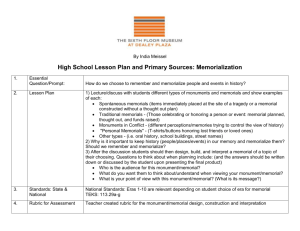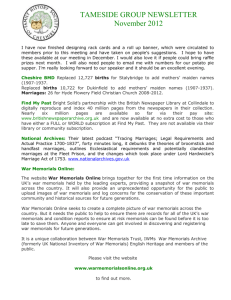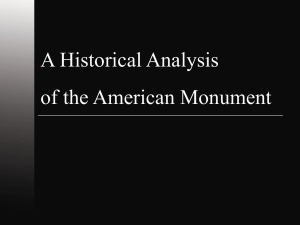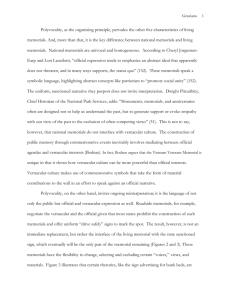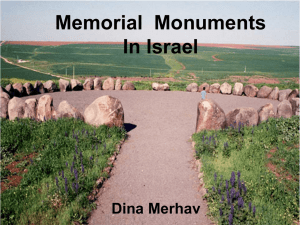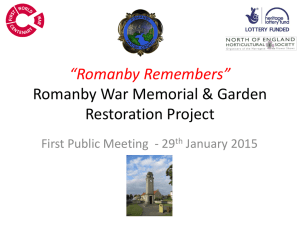amy davidson war memorials
advertisement
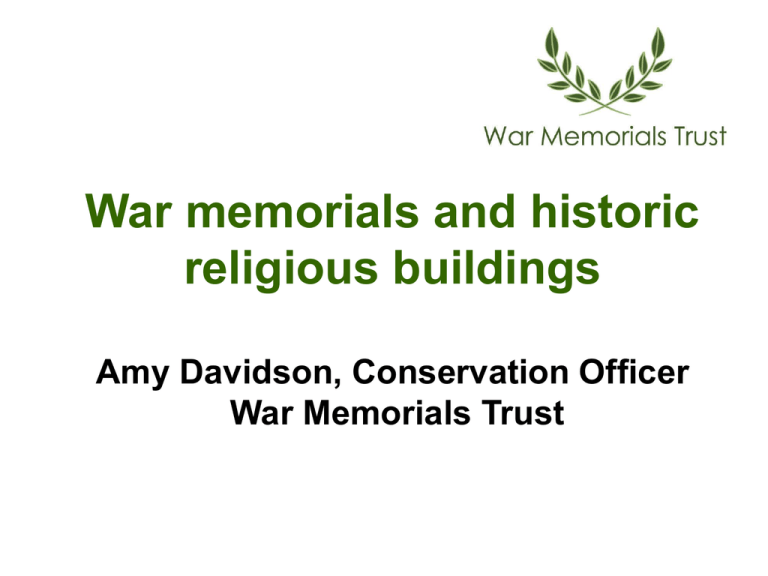
War memorials and historic religious buildings Amy Davidson, Conservation Officer War Memorials Trust War Memorials Trust • Independent charity, rely on donations to undertake our work and fund our grant schemes • Established 1997 due to concern about the condition of war memorials in the UK • Conservation charity: give advice and information, administer grant schemes - not responsible for any memorials • No legal powers so cannot require anyone to do anything. Objectives 1. To monitor the condition of war memorials and to encourage protection and conservation 2. To provide expert advice to those involved in war memorial projects, to act as the specialist organisation for war memorial conservation issues and to facilitate repair and conservation through grant schemes 3. To work with relevant organisations to encourage them to accept responsibility for war memorials and recognise the need to undertake repair and conservation work 4. To build a greater understanding of war memorial heritage and raise awareness of the issues surrounding war memorial conservation. WMT Structure Board of Trustees Director Administrator Membership & Volunteer Officer Learning Officer Conservation Officers x4 History of war memorials • Estimated 100,000 war memorials in the UK • Traditionally war memorials were dedicated to the officer ranks (Napoleonic Wars) • Public memorials to ordinary soldiers began to appear in the 19th century (Crimean and Boer Wars) • Mass memorialisation conscripted soldiers during after World War I. for and All Saints’ Church, Corston, Bath © Benjamin & Beauchamp Architects Ltd, 2010 History of war memorials • After World War II names added to existing memorials or built utilitarian types • Names continue to be added to existing memorials or new ones are created • No central government directives about design or who was remembered • The majority of war memorials were funded by public subscription through committees formed for their commission and usually dissolved after completion • A formal transfer of responsibility/ ownership may have occurred after the war memorial’s dedication/creation. St Michael and All Angels Church, Michaelston le Pit, Glamorgan © WMT, 2011 Diversity of type and materials War memorials in HRBs • Varied location and design which may not be obvious • Majority relate to CofE churches • Common to have a cross monument in a churchyard or • May be functional or items usually seen in places of worship e.g. chapels, rood screens, bells, clocks, organs • Common to see memorials to individuals as well as communities; plaques and windows • May be dedicated to a group specific to the place of worship e.g. choir. St Mary the Virgin Church memorial clock, Romney Marsh, Kent © St Mary the Virgin PCC, 2010 Custodianship What is a ‘custodian’? Anyone who looks after the maintenance of a war memorial. They may or may not be the legal owner. May need to undertake research to establish this but many war memorials have no identifiable custodian or owner. Many types of custodians: • Parochial Church Councils • Parish, town, district councils • Individuals/companies • Regiments • Specific memorial trusts • Local community groups (e.g. civic societies) • CWGC (official memorials) The following are not custodians: • War Memorials Trust • Royal British Legion • Imperial War Museums • Ministry of Defence • CWGC (for local memorials) The law: maintenance War Memorials (Local Authorities’ Powers) Act of 1923 “A local authority may incur reasonable expenditure in the maintenance, repair and protection of any war memorial within their district, which may be vested in them”. Local Authorities Act 1948/ Local Government Act 1948 This later Act allows expenditure to be incurred for memorials “which may be vested in them or not”. Means many local authorities undertake projects to memorials at a PoW. Common issues in HRBs • Ownership • Lack of records • Closing buildings or merging of congregations • Relocation • Accessibility • Anti-social behaviour / theft St Peter's Church (CCT), Offord D’Arcy, Cambs. © E. Howes, 2013 Centenary of WWI 2014-18 • Various projects nationally locally and • Opportunity to record and assess your memorials • Opportunity education for events and • May be local notable dates –Pals Battalions, or national onesBattle of the Somme etc. • Funding opportunities © WMT, 2012 How WMT can help: Advice • Helpsheets – technical and general. Include landscapes; adding names; mortar; condition survey • Website – various types of advice: grants and advice for applicants; other sources of funding; War Memorials Officers; bibliography • Conservation Officers St Bartholomew's Church memorial organ, Warleggan, Cornwall © Warleggan PCC, 2011 How WMT can help: Grants • Small Grants Scheme (UK) Funded by WMT. All war memorials in the UK eligible. Max grant of up to 50% of costs, up to £2,500. No deadlines. • Grants for War Memorials (Freestanding in England) Funded by English Heritage / The Wolfson Foundation. Max grant of up to 75% of costs, up to £30k (minimum project cost £3k). Four deadlines per year. • Centenary Memorials Restoration Fund (Scotland) Funded by the Scottish Government through Historic Scotland - £1m available 2013-2018. All memorials in Scotland eligible. Max grant of up to 75% of costs, up to £30k. Four deadlines per year. www.warmemorials.org/grants Grant eligible works • Cleaning • Addition of names • Conservation works • Condition/structural surveys • Like-for-like repairs • Improving access • Re-cutting/sharpening up inscriptions where required • Reinstatement elements of lost St James's Church, Berwick St James, Wilts. © S. Bush, 2009-2010 Grants: Case studies The Memorial Bells, Memorial Community Church, Plaistow, London • £2,500 grant • Repair and cleaning of bells and clavier • Also received HLF funding • Produced website with details of those commemorated © Memorial Community Church, 2011 Grants: Case studies All Saints' Church WWI plaque, West Dulwich, London • £650 grant • Repair of plaque after fire © All Saints’ West Dulwich, 2010 Grants: Case studies St Margaret's Church cross, Hollinwood, Manchester • £308 grant • Repair and replacement of delaminating stone © Storah Architecture, 2011 © St Margaret's Church, 2011 Grants: Case studies Our Lady Star of the Sea Church, Castlebay, Isle of Barra, Western Isles, Scotland • £10k grant • Cleaning, repair cracks, re-lead and solder, masonry repairs © Benjamin Tindall Architects, 2011 © Paul Harding, 2012 Other sources of funding • WMT grant schemes are unable to fund 100% • HLF – First World War: then and now. £3-£10k • Memorials Grant Scheme – VAT reimbursement St Mary Magdalene's Church memorial rood screen, Wandsworth Common, London © Philip McCarthy Photography, 2010 How WMT Projects can help: • War Memorials Online: www.warmemorialsonline.org.uk • In Memoriam 2014: www.inmemoriam2014.org • Learning Programme: www.learnaboutwarmemorials.org • War Memorials Officers: www.warmemorials.org/wmo St Peter's Church, Woolhampton, Berks. © Woolhampton Parish Council, 2013 Contact details War Memorials Trust 42a Buckingham Palace Road London SW1W 0RE E: conservation@warmemorials.org T: 020 7233 7356 W: www.warmemorials.org Twitter: @WarMemorials Questions?
